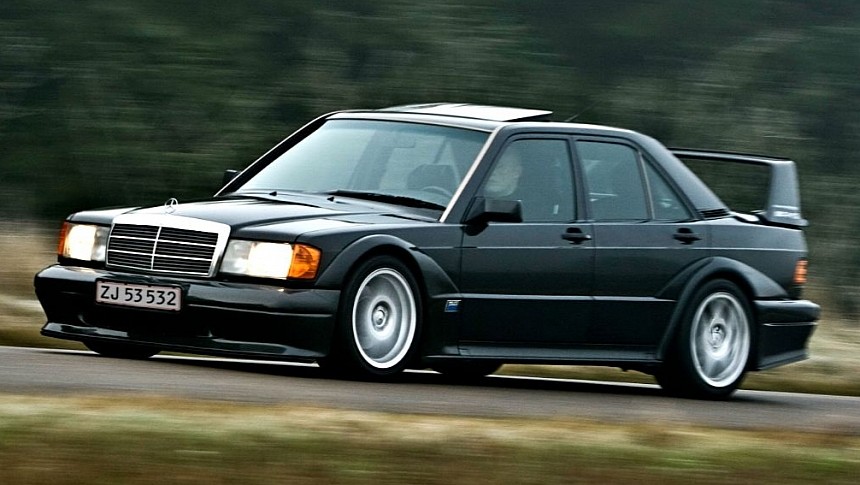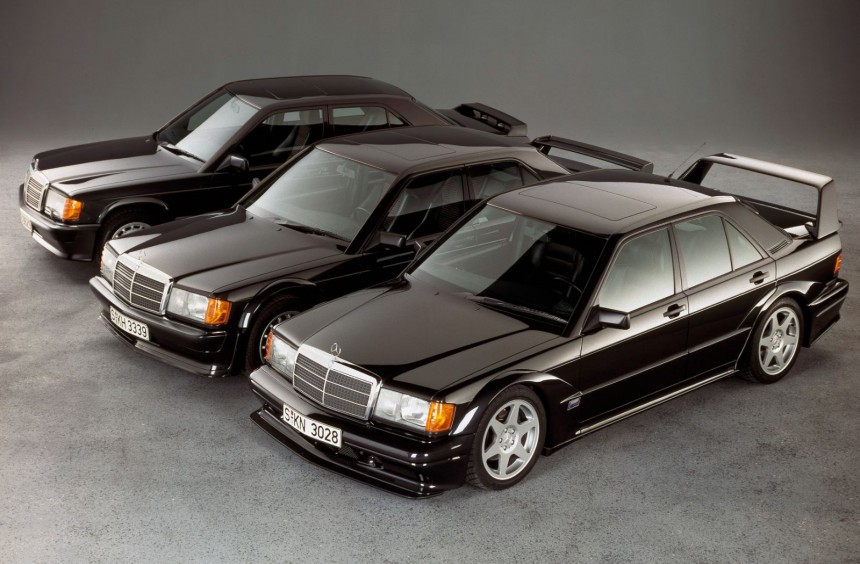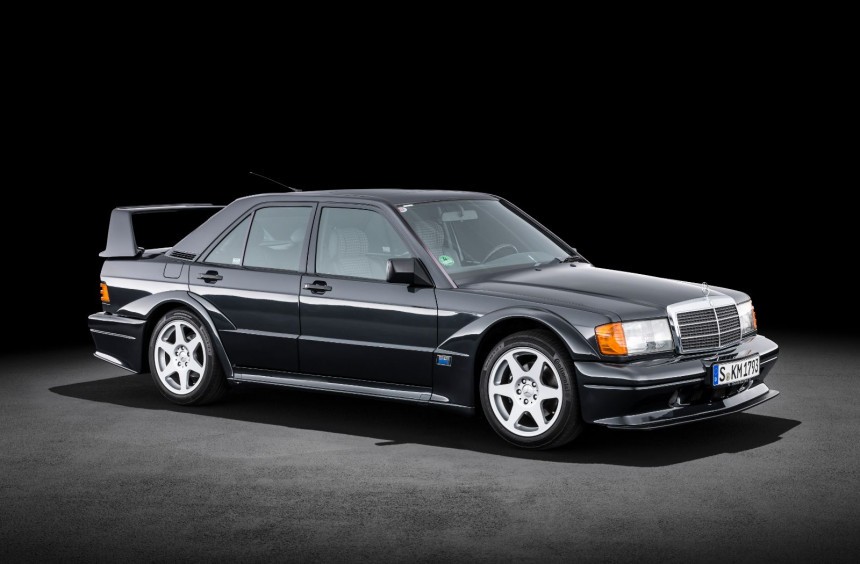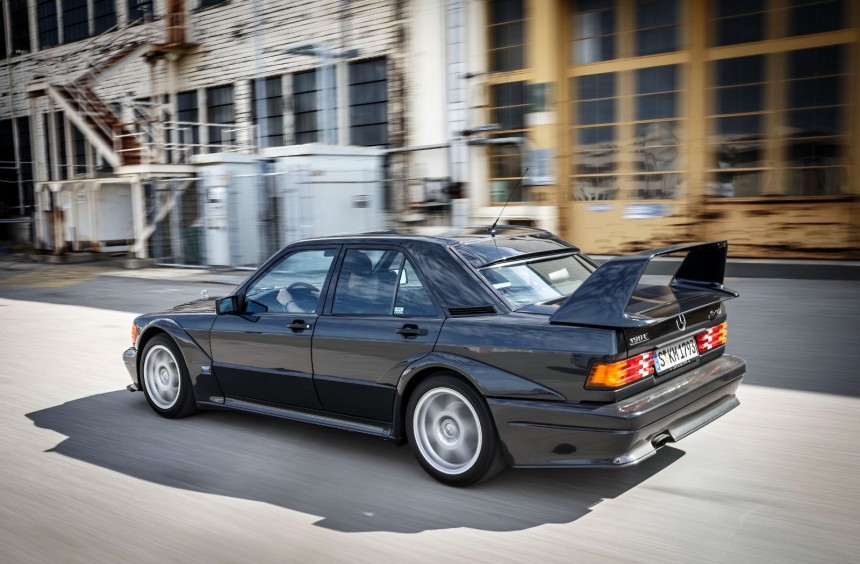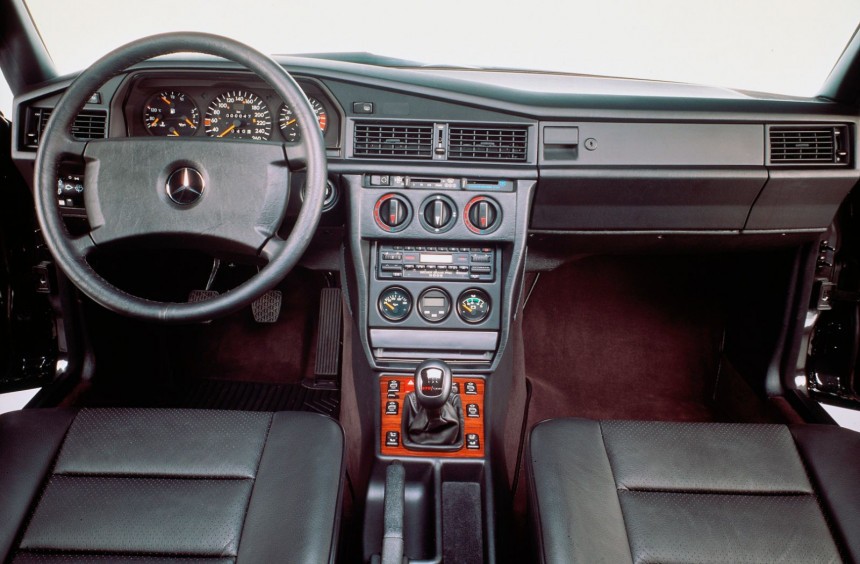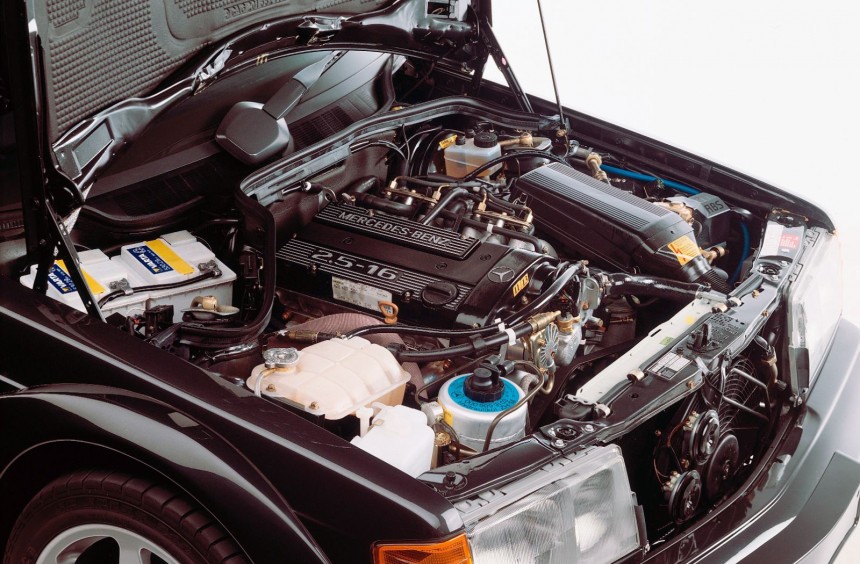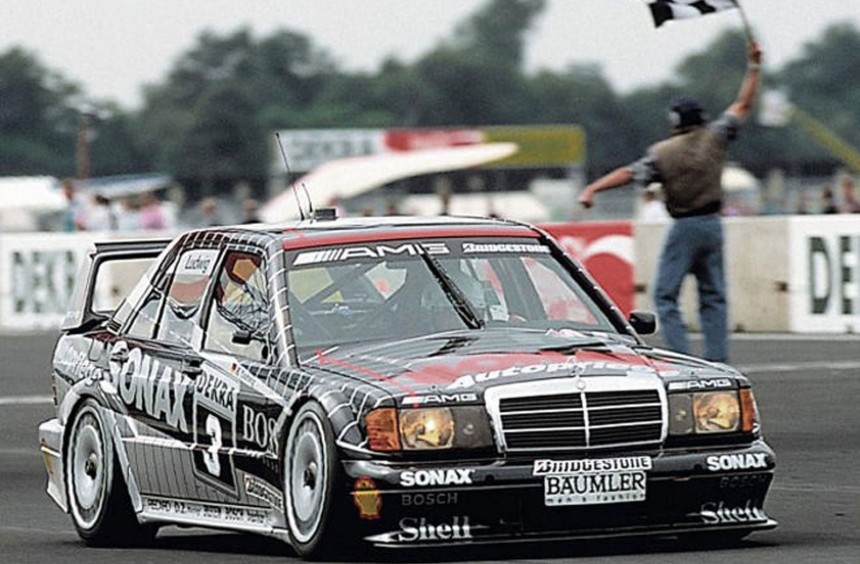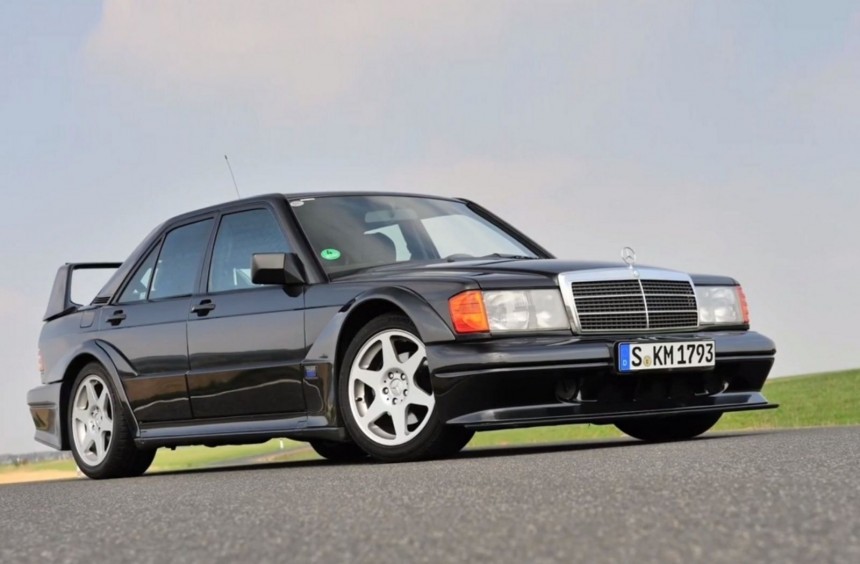Produced in a limited series of just over 500 units, the 2.5-16 Evolution II was one of the wildest homologation specials from the 1990s.
Since the early days of the automobile, manufacturers have used motorsport as the most effective means of promoting their products.
Though progress was hindered by the two world wars, by the 1950s, grand prix racing contributed to the emergence of innovative, highly powerful sports cars that could be legally driven on public roads but were developed for the track.
Three decades later, motorsport - and thus high-performance road cars - entered a new dimension thanks to significant advancements in aerodynamics and engineering.
Formula 1, grand touring championships, or endurance racing became more popular than ever. Even rallying entered its golden age thanks to the use of turbocharging and four-wheel-drive systems.
The tech pioneered in these competitions trickled down to road cars and also led to the creation of some legendary homologation specials.
No, the 190E 2.5-16 Evolution II two was not developed for rallying, but it was the culmination of a program that started in the early 1980s with Mercedes' ambition to enter the W201 190 series in the World Rally Championship (WRC).
To do that, the Germans commissioned British engineering experts Cosworth to help develop a four-cylinder capable of making over 300 hp.
Using an existing Mercedes M102 block, Cosworth developed an all-new DOHC 16-valve cylinder head loosely based on the mighty DFV Formula 1 V8's heads.
However, by the time the naturally aspirated engine was ready, the rally world was transitioning to turbocharging and four-wheel-drive, thanks to the trend-setting quattro unleashed by rivals Audi.
The rally program was canceled, and Mercedes shifted its focus to the domestic touring car championship, the newly-established DTM (Deutsche Tourenwagen Meisterschaft).
Equipped with the Cosworth-engineered four-pot (initially a 2.3-liter, ten enlarged to 2.5), the 190 E became a potent touring car and, for homologation purposes, a couple of Cosworth-engined road cars (190 E 2.3-16 and 2.5-16) were introduced.
By 1989, the DTM championship-winning drivers (a manufacturer's title was not awarded until 1991) drove either a Volvo, Rover, Ford, or BMW, with the Bavarians winning two of the first five editions of the championship.
Alongside then-independent tuners and race team AMG, Mercedes was competitive but not good enough to grab the title, which went to BMW M3 driver Roberto Ravaglia in 1989.
The Stuttgart-based carmaker tried to stop its Bavarian rivals' run of dominance by introducing the aerodynamically-improved E 2.5-16 Evolution (aka Evo I) in March 1989, but the car was no match for the revised M3 Evolution.
To make matters worse, BMW announced the improved M3 dubbed Sport Evolution in December 1989, so Mercedes decided to take the 2.5-16 to the next level with the new Evolution II.
Mercedes realized that the car needed to be faster, and to achieve that, it required another aero makeover.
The manufacturer enlisted the help of Prof. Richard Eppler, a renowned aerodynamicist from the University of Stuttgart who designed a radical body kit for the improved Evo II.
Wind-tunnel-tested, the fiberglass kit included redesigned bumpers, skirts, wheel arches, a rear window spoiler, and the largest adjustable rear wing ever fitted on a Mercedes sedan.
As with its predecessors, the Evo II could race in the DTM only if 500 road-legal units were produced, so in March 1990, at the Geneva Auto Show, the street-legal car made its debut and entered production several months later.
The homologation special donned the aero improvements conceived for the track, all of which improved downforce and also reduced drag to a coefficient of 0.29.
While the car's exterior made it the wildest-looking series production Mercedes sedan ever built, the interior was all business.
All the premium features available for the 190E, such as power windows, leather-upholstered, power-assisted heated seats, air conditioning, or woodgrain trims, were all standard on the Evo II.
Moreover, the homologation special received its predecessor's large disc brake setup and hydraulic self-leveling suspension (SLS), complete with an interior knob that allowed drivers to switch select the desired ride height.
Like the Evo I, its successor received a 2.5-liter four-cylinder. Though it was nearly identical, carrying over the Cosworth-engineered DOHC 16-valve aluminum head, the engine received a new codename: M 102 992.
The renaming signaled an improved setup with a higher compression ratio, a new high-performance exhaust system, and a standard AMG power pack (optional on the Evo I).
Developed by Mercedes' premier tuners and race team, the AMG power pack added hotter cams, a large-diameter throttle body, a high-performance fuel management system, and an improved intake.
The engine was rated at 232 hp at 7,200 rpm and 181 lb-ft (245 Nm) of torque at 5,000 rpm, impressive figures for a naturally aspirated four-cylinder developed in 1990.
All that power was sent to the rear wheels through a five-speed manual and an electronically controlled limited-slip differential (dubbed Anti-Slip Differential or ASD).
A succesful DTM career
The improved car made its race debut during the 1990 DTM season's sixth round held at the Nurburgring in June, with AMG-Mercedes drivers Kurt Thiim and Klaus Ludwig each receiving one.
Neither car finished its debut race, and the following sixteen rounds didn't go as the team hoped either.
AMG-Mercedes won a single race that season, with Thiim finishing third in the overall standings behind BMW's Johnny Cecotto and champion Hans-Joachim Stuck of DTM newcomers Audi.
The 1991 season was a definite improvement. Klaus Ludwig finished second in the drivers' standings, but AMG-Mercedes racked up enough points to lift the inaugural DTM manufacturers' trophy.
Then, in 1992, the aging Evo II brought Ludwig his second drivers' title and helped AMG-Mercedes defend its manufacturers' trophy.
A 1990-only model, the Evo II was produced in 502 units. All but two were finished in a blue-black metallic paint called Blauschwarz. The exceptions were reportedly commissioned by wealthy buyers and received an Astral Silver finish.
During its heyday, the Evo II competed against the M3 Sport Evolution on the track and showroom floor, where BMW delivered 98 more examples than Mercedes to meet the high demand.
Since the Evo II is rarer and has a DTM title to its name, the model is currently more expensive than its rival. According to classics.com, the average value for an Evo II currently stands at $293,734, nearly $100,000 more than an M3 Sport Evolution.
Though Mercedes developed crazier race-bred street models like the CLK DTM AMG, the Evo II remains one of its most legendary production models and one of the wildest homologation specials of the 1990s.
If you want to see this German icon in action, we recommend watching the YouTube video below by Petrolicious.
Moreover, if you want to drive one but can only afford a PlayStation 5 and a sim rig, the Evo II has been recently added to the Gran Turismo 7 car lineup.
Though progress was hindered by the two world wars, by the 1950s, grand prix racing contributed to the emergence of innovative, highly powerful sports cars that could be legally driven on public roads but were developed for the track.
Three decades later, motorsport - and thus high-performance road cars - entered a new dimension thanks to significant advancements in aerodynamics and engineering.
Formula 1, grand touring championships, or endurance racing became more popular than ever. Even rallying entered its golden age thanks to the use of turbocharging and four-wheel-drive systems.
The tech pioneered in these competitions trickled down to road cars and also led to the creation of some legendary homologation specials.
It all began with rallying
To do that, the Germans commissioned British engineering experts Cosworth to help develop a four-cylinder capable of making over 300 hp.
Using an existing Mercedes M102 block, Cosworth developed an all-new DOHC 16-valve cylinder head loosely based on the mighty DFV Formula 1 V8's heads.
However, by the time the naturally aspirated engine was ready, the rally world was transitioning to turbocharging and four-wheel-drive, thanks to the trend-setting quattro unleashed by rivals Audi.
The rally program was canceled, and Mercedes shifted its focus to the domestic touring car championship, the newly-established DTM (Deutsche Tourenwagen Meisterschaft).
Equipped with the Cosworth-engineered four-pot (initially a 2.3-liter, ten enlarged to 2.5), the 190 E became a potent touring car and, for homologation purposes, a couple of Cosworth-engined road cars (190 E 2.3-16 and 2.5-16) were introduced.
Created to rival the BMW M3
Alongside then-independent tuners and race team AMG, Mercedes was competitive but not good enough to grab the title, which went to BMW M3 driver Roberto Ravaglia in 1989.
The Stuttgart-based carmaker tried to stop its Bavarian rivals' run of dominance by introducing the aerodynamically-improved E 2.5-16 Evolution (aka Evo I) in March 1989, but the car was no match for the revised M3 Evolution.
To make matters worse, BMW announced the improved M3 dubbed Sport Evolution in December 1989, so Mercedes decided to take the 2.5-16 to the next level with the new Evolution II.
A wild body kit designed by a college professor
The manufacturer enlisted the help of Prof. Richard Eppler, a renowned aerodynamicist from the University of Stuttgart who designed a radical body kit for the improved Evo II.
Wind-tunnel-tested, the fiberglass kit included redesigned bumpers, skirts, wheel arches, a rear window spoiler, and the largest adjustable rear wing ever fitted on a Mercedes sedan.
As with its predecessors, the Evo II could race in the DTM only if 500 road-legal units were produced, so in March 1990, at the Geneva Auto Show, the street-legal car made its debut and entered production several months later.
Wing warrior outside, luxury sedan inside
While the car's exterior made it the wildest-looking series production Mercedes sedan ever built, the interior was all business.
All the premium features available for the 190E, such as power windows, leather-upholstered, power-assisted heated seats, air conditioning, or woodgrain trims, were all standard on the Evo II.
Moreover, the homologation special received its predecessor's large disc brake setup and hydraulic self-leveling suspension (SLS), complete with an interior knob that allowed drivers to switch select the desired ride height.
The Cosworth-engineered, AMG-tuned jewel hidden under the hood
The renaming signaled an improved setup with a higher compression ratio, a new high-performance exhaust system, and a standard AMG power pack (optional on the Evo I).
Developed by Mercedes' premier tuners and race team, the AMG power pack added hotter cams, a large-diameter throttle body, a high-performance fuel management system, and an improved intake.
The engine was rated at 232 hp at 7,200 rpm and 181 lb-ft (245 Nm) of torque at 5,000 rpm, impressive figures for a naturally aspirated four-cylinder developed in 1990.
All that power was sent to the rear wheels through a five-speed manual and an electronically controlled limited-slip differential (dubbed Anti-Slip Differential or ASD).
A succesful DTM career
Neither car finished its debut race, and the following sixteen rounds didn't go as the team hoped either.
AMG-Mercedes won a single race that season, with Thiim finishing third in the overall standings behind BMW's Johnny Cecotto and champion Hans-Joachim Stuck of DTM newcomers Audi.
The 1991 season was a definite improvement. Klaus Ludwig finished second in the drivers' standings, but AMG-Mercedes racked up enough points to lift the inaugural DTM manufacturers' trophy.
Then, in 1992, the aging Evo II brought Ludwig his second drivers' title and helped AMG-Mercedes defend its manufacturers' trophy.
The Mercedes-Benz 190E 2.5-16 Evolution II today
During its heyday, the Evo II competed against the M3 Sport Evolution on the track and showroom floor, where BMW delivered 98 more examples than Mercedes to meet the high demand.
Since the Evo II is rarer and has a DTM title to its name, the model is currently more expensive than its rival. According to classics.com, the average value for an Evo II currently stands at $293,734, nearly $100,000 more than an M3 Sport Evolution.
Though Mercedes developed crazier race-bred street models like the CLK DTM AMG, the Evo II remains one of its most legendary production models and one of the wildest homologation specials of the 1990s.
If you want to see this German icon in action, we recommend watching the YouTube video below by Petrolicious.
Moreover, if you want to drive one but can only afford a PlayStation 5 and a sim rig, the Evo II has been recently added to the Gran Turismo 7 car lineup.
